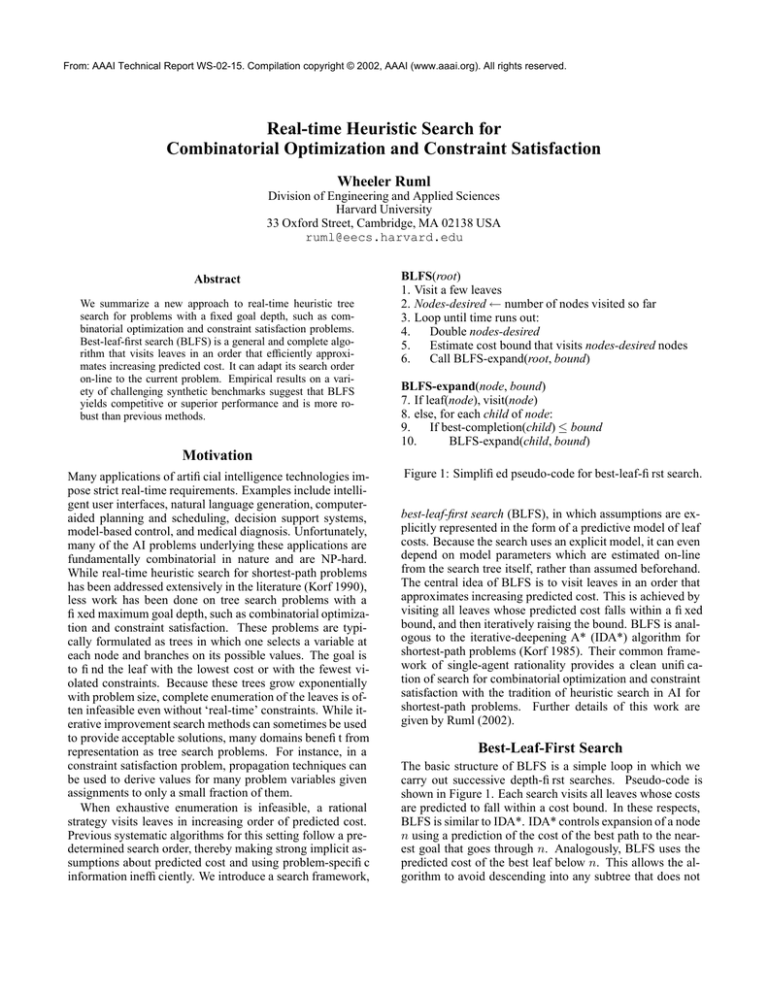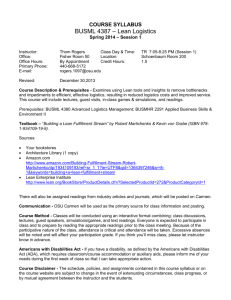
From: AAAI Technical Report WS-02-15. Compilation copyright © 2002, AAAI (www.aaai.org). All rights reserved.
Real-time Heuristic Search for
Combinatorial Optimization and Constraint Satisfaction
Wheeler Ruml
Division of Engineering and Applied Sciences
Harvard University
33 Oxford Street, Cambridge, MA 02138 USA
ruml@eecs.harvard.edu
Abstract
We summarize a new approach to real-time heuristic tree
search for problems with a fixed goal depth, such as combinatorial optimization and constraint satisfaction problems.
Best-leaf-first search (BLFS) is a general and complete algorithm that visits leaves in an order that efficiently approximates increasing predicted cost. It can adapt its search order
on-line to the current problem. Empirical results on a variety of challenging synthetic benchmarks suggest that BLFS
yields competitive or superior performance and is more robust than previous methods.
BLFS(root)
1. Visit a few leaves
2. Nodes-desired ← number of nodes visited so far
3. Loop until time runs out:
4.
Double nodes-desired
5.
Estimate cost bound that visits nodes-desired nodes
6.
Call BLFS-expand(root, bound)
BLFS-expand(node, bound)
7. If leaf(node), visit(node)
8. else, for each child of node:
9.
If best-completion(child) ≤ bound
10.
BLFS-expand(child, bound)
Motivation
Many applications of artificial intelligence technologies impose strict real-time requirements. Examples include intelligent user interfaces, natural language generation, computeraided planning and scheduling, decision support systems,
model-based control, and medical diagnosis. Unfortunately,
many of the AI problems underlying these applications are
fundamentally combinatorial in nature and are NP-hard.
While real-time heuristic search for shortest-path problems
has been addressed extensively in the literature (Korf 1990),
less work has been done on tree search problems with a
fixed maximum goal depth, such as combinatorial optimization and constraint satisfaction. These problems are typically formulated as trees in which one selects a variable at
each node and branches on its possible values. The goal is
to find the leaf with the lowest cost or with the fewest violated constraints. Because these trees grow exponentially
with problem size, complete enumeration of the leaves is often infeasible even without ‘real-time’ constraints. While iterative improvement search methods can sometimes be used
to provide acceptable solutions, many domains benefit from
representation as tree search problems. For instance, in a
constraint satisfaction problem, propagation techniques can
be used to derive values for many problem variables given
assignments to only a small fraction of them.
When exhaustive enumeration is infeasible, a rational
strategy visits leaves in increasing order of predicted cost.
Previous systematic algorithms for this setting follow a predetermined search order, thereby making strong implicit assumptions about predicted cost and using problem-specific
information inefficiently. We introduce a search framework,
Figure 1: Simplified pseudo-code for best-leaf-first search.
best-leaf-first search (BLFS), in which assumptions are explicitly represented in the form of a predictive model of leaf
costs. Because the search uses an explicit model, it can even
depend on model parameters which are estimated on-line
from the search tree itself, rather than assumed beforehand.
The central idea of BLFS is to visit leaves in an order that
approximates increasing predicted cost. This is achieved by
visiting all leaves whose predicted cost falls within a fixed
bound, and then iteratively raising the bound. BLFS is analogous to the iterative-deepening A* (IDA*) algorithm for
shortest-path problems (Korf 1985). Their common framework of single-agent rationality provides a clean unification of search for combinatorial optimization and constraint
satisfaction with the tradition of heuristic search in AI for
shortest-path problems. Further details of this work are
given by Ruml (2002).
Best-Leaf-First Search
The basic structure of BLFS is a simple loop in which we
carry out successive depth-first searches. Pseudo-code is
shown in Figure 1. Each search visits all leaves whose costs
are predicted to fall within a cost bound. In these respects,
BLFS is similar to IDA*. IDA* controls expansion of a node
n using a prediction of the cost of the best path to the nearest goal that goes through n. Analogously, BLFS uses the
predicted cost of the best leaf below n. This allows the algorithm to avoid descending into any subtree that does not
-12.8
Log10(Difference)
Fraction of Problems Solved
0.8
DDS
DFS
ILDS
BLFS
0.6
0.4
BLFS
ILDS (bottom)
ILDS (top)
DDS
DFS
0.2
2.7
3.0
3.3
3.6
-13.2
-13.6
-14.0
3.9
Log10(Nodes Generated)
400,000
800,000
1,200,000
1,600,000
2,000,000
Nodes Generated
Figure 2: Distribution of search times for latin squares.
Figure 3: Anytime profiles for partitioning 256 numbers
contain a leaf we wish to visit on this iteration (step 9). However, BLFS uses an explicit representation of its predictive
model, rather than a black-box function suppled by the user,
as in IDA*. Being able to choose a simple model leads to
two important advantages over IDA*. First, we can choose a
model that will give consistent predictions. That is to say, we
can ensure that for every node there exists a child whose best
descendant will have the same evaluation. This means that
BLFS is certain to reach leaves on every iteration, never expanding a node unnecessarily and never overlooking a node
that has a descendant within the cost bound. IDA* does not
generate any leaves until it has generated all internal nodes
whose cost is less than that of the optimal leaf, and is therefore useless for real-time applications. The second advantage that BLFS enjoys over IDA* is that the cost bound can
be updated optimally. Because the predicted costs are generated by a known model, we can choose cost bounds that can
be expected to cause twice as many nodes to be visited as on
the previous iteration (step 5). By approximately doubling
the number of nodes visited on each iteration, BLFS limits
its overhead to a factor of less than three in the worst-case
situation in which the entire tree must be searched.
hopeless lost on many problems. The discrepancy search
algorithms immediately retreat to the root. BLFS first explores all ties, which may occur at intermediate levels of the
tree, and it solves all the problems within 4,000 nodes (note
the logarithmic scale). Its relatively compact run-time distribution is superior for real-time applications. The advantage
of BLFS search over the discrepancy methods seemed to increase as problems grew larger (not shown here).
In number partitioning, one attempts to divide a given set
of numbers into two disjoint groups such that the difference
between the sums of the two groups is as small as possible
(Korf 1995). The logarithm of this difference was used as
the leaf cost. A predictive model of leaf cost was learned
during the search. Figure 3 compares the anytime performance profile of BLFS with those of DFS, ILDS, and DDS.
The vertical axis represents the partition difference of the
best solution found so far, which we are attempting to minimize. Error bars represent 95% confidence intervals on the
mean. BLFS surpasses the other algorithms throughout, and
its advantage increases with problem size (not shown here).
Acknowledgments
Selected Results
A latin square is an n by n array in which each cell has
one of n colors. Each row and column must contain each
color exactly once. We preassigned 30% of the cells. We
tested depth-first search (DFS), two version of Korf’s improved limited discrepancy search (ILDS, Korf, 1996), one
taking discrepancies at the top first and the other taking them
at the bottom first, depth-bounded discrepancy search (DDS,
Walsh, 1997), and BLFS. The number of variables left unassigned when the first constraint violation was detected was
used as the cost of each leaf. Space limitations prevent description of the leaf cost model.
The performance of the algorithms is shown in Figure 2
in terms of the fraction of problems solved within a given
number of node generations. From the figure, we see that
25% of the problems were solved by visiting a single leaf
(the greedy solution). But depth-first search, the most common tree search technique, is amazingly brittle and becomes
Thanks to Stuart Shieber, the Harvard AI Research Group,
and NSF grants CDA-94-01024 and IRI-9618848.
References
Korf, R. E. 1985. Depth-first iterative-deepening: An optimal admissible tree search. AIJ 27(1):97–109.
Korf, R. E. 1990. Real-time heuristic search. AIJ 42:189–
211.
Korf, R. E. 1995. From approximate to optimal solutions:
A case study of number partitioning. In Proc IJCAI-95.
Korf, R. E. 1996. Improved limited discrepancy search. In
Proceedings of AAAI-96, 286–291.
Ruml, W. 2002. Heuristic search in bounded-depth trees:
Best-leaf-first search. TR-01-02, Harvard University.
Walsh, T. 1997. Depth-bounded discrepancy search. In
Proceedings of IJCAI-97.








